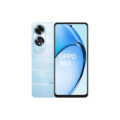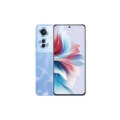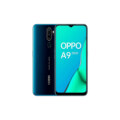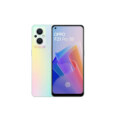Oppo A54
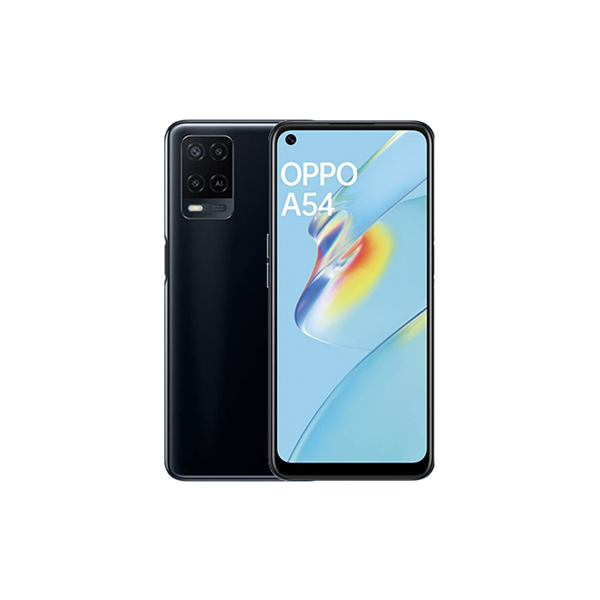
Specs
General
| Device Type | Oppo phone |
| Announced | 26 March, 2021 |
| Released | 26 March, 2021 |
| Status | Available |
Design
| Dimensions | 163.6 x 75.7 x 8.4 mm |
| Weight | 192 g |
| Colors | Crystal Black, Starry Blue |
Display
| Refresh Rate | 60 Hz |
| Display Type Display Technology => A number of display technologies and types used in mobile phones => TFT (Thin Film Transistor), IPS (In-Place Switching), OLED (Organic Light Emitting Diode), AMOLED (Active-Matrix Organic Light-Emitting Diode), Super AMOLED (an even advanced version of AMOLED), Resistive Touchscreen (Resistive touchscreens contain two layer of conductive material with a very small gap between them which acts as a resistance), Capacitive Touchsceen (Capacitive touchscreen technology consists of a layer of glass coated with a transparent conductor) | IPS LCD |
| Size | 6.51 inches (16.54 cm) |
| Resolution | 720x1600 px (HD+) |
| Display Colors Display Colors is refers to the number of different shades of colors that the screen is capable of displaying => 64K colors, 256K colors and 16 million colors, Obviously 16M is highest available range of colors and better than others. | 16M colors |
| Pixel Density Pixel Density (PPI) is refers to the concentration of pixels on a particular display, measured in pixels per inch (ppi). Pixel density is calculated by dividing the diagonal pixel resolution of a display by its diagonal size, higher pixel density better display quality. | 270 ppi |
| Touch Screen | Capacitive Touchscreen, Multi-touch |
| Features | 800 nits |
| Secondary Display | No |
Camera
| Front Camera | 16 MP, f/2.0, (wide), 1/3.06", 1.0µm |
| Camera Setup | Triple |
| Main Camera Camera is able to capture photographs and usually videos, The most important characteristics of a camera are the resolution (measured in megapixels), lens focus type (fixed or automatic), higher megapixel cameras are known to capture higher quality photos, but not always a good measurement of the photos quality. |
13 MP, f/2.2, 25mm (wide), 1/3.06", 1.12µm, PDAF 2 MP, f/2.4, (macro) 2 MP, f/2.4, (depth) |
| Image | 4128 x 3096 Pixels |
| Video | 1080p@30fps |
| Camera Features | Geo-tagging, touch focus, face detection, HDR, panorama |
| Flash Flash Light => There is commonly two types of flash lights are used in camera mobile phones, LED Flash (LED flash offers lower power consumption with drive circuitry that takes up very little room, LEDs can be strobed faster than any other light source), Xenon Flash (xenon flash produces an extremely intense full-spectrum white light for a very short duration) | LED flash, HDR, panorama |
Hardware
| Operating System OS => Every computer system run on a base software called Operating System (OS). Operating System controls all basic operations of the computer (such as smartphone, PDAs, tablet computers and other handheld devices). The Operating System allows the user to install and run third party applications (apps), apps are used to add new functionality to the device. | Android 11 |
| Chipset Chipset is a group of integrated circuits designed to perform one or a more dedicated functions, often with real time computing constraints, Popular smartphones are equipped with more advanced embedded chipsets that can do many different tasks depending on their programming. | MediaTek Helio P35 |
| CPU CPU (Central Processing Unit) mostly known as processors, CPU processes instructions in order to carry out certain functions that make your device operate properly. Processors are often described as the brain of computers, smartphones and tablets, Smartphones and tablets rely on processors to carry out their every task, Processors are an incredibly important factor in selecting any type of computing device, including your smartphone. | Octa-core (4 x 2.35 GHz Cortex-A53 + 4 x 1.8 GHz Cortex-A53) |
| Architecture | 64 bit |
| Fabrication | 12 nm |
| GPU GPU (Graphics Processing Unit) is a single-chip processor designed to rapidly manipulate and alter memory to accelerate the creation of images in a frame buffer intended for output to a display, This includes things such as lighting effects, object transformations, and 3D motion. | PowerVR GE8320 |
| RAM (Memory) RAM (Random Access Memory) is a type of computer memory that can be accessed randomly, any byte of memory can be accessed without touching the preceding bytes that allows information to be stored and accessed quickly from random locations. RAM is the most common type of memory found in computer systems, smartphones, tablets and other electronic devices. | 4 GB |
| Internal Storage Internal Storage is a data storage space (flash memory) mostly used in smartphones, tablets and other electronic devices where operating system, apps, music, photos, videos, files and other user data Is stored. | 128 GB |
| Card Slot Memory Card Slot is a special slot for inserting a memory card. Memory cards allow you to expand the phone's built-in memory, A memory card (sometimes called a flash memory card or a storage card) is a small storage medium used to store data such as text, pictures, audio, and video, for use on small, portable or remote computing devices such as mobile phones, mp3 players, digital cameras. | |
| Sensors Sensors are electronic components that detects and responds to some type of input from the physical environment. The specific input could be light, heat, motion, moisture, pressure and location, The output is generally a signal that is converted to use in computing systems, a location sensor, such as a GPS receiver is able to detect current location of your electronic device. | Fingerprint (side-mounted), accelerometer, proximity, compass |
Network
| SIM TYPE SIM (Subscriber Identity Module) is a small card that contains mobile network subscriber's account information. This allows the phone using the card to attach to a mobile network. The SIM card is most commonly associated with GSM and UMTS mobile networks. Moving a SIM card from one phone to another allows a subscriber to switch mobile phones without having to contact their mobile network carrier. SIM cards can also be used by a phone to store limited amounts of data, such as phone numbers and text messages. | Nano SIM |
| SIM Technology | Dual Sim, Dual Standby |
| 2G Network | GSM 850 / 900 / 1800 / 1900 |
| 3G Network | HSDPA 850 / 900 / 1900 / 2100 |
| 4G Network | LTE band 1(2100), 3(1800), 5(850), 7(2600), 8(900), 20(800), 28(700), 38(2600), 40(2300), 41(2500) |
Multimedia
| FM Radio | |
| Stereo Speakers | NO |
| Loudspeaker | YES |
| Audio Jack | 3.5mm Audio Jack |
| Audio Features | 24-bit/192kHz Hi-Res audio |
Connectivity
| Wi-fi Wi-Fi is a popular wireless networking technology using radio waves to provide high-speed network connections that allows devices to communicate without cords or cables, Wi-Fi is increasingly becoming the preferred mode of internet connectivity all over the world. | Wi-Fi 802.11 a/b/g/n/ac, dual-band, Wi-Fi Direct |
| Bluetooth Bluetooth is a wireless communications technology for exchanging data between mobile phones, headsets, computers and other network devices over short distances without wires, Bluetooth technology was primarily designed to support simple wireless networking of personal consumer devices. | v5.0 with A2DP, LE, apt-X HD |
| GPS GPS The Global Positioning System is a satellite-based radio navigation system, GPS permits users to determine their position, velocity and the time 24 hours a day, in all weather, anywhere in the world, In order to locate your position, your device or GPS receiver must have a clear view of the sky. | A-GPS support & Glonass, BDS, GALILEO |
| USB | USB Type-C 2.0, USB On-The-Go |
| EDGE EDGE (Enhanced Data GSM Environment) is a wireless network technology generally considered the next step in the 2G network offers data transfer rates up to four times faster than ordinary GSM networks, Generally, EDGE is used for the purpose of wireless data transfer, such as sharing pictures and videos or browsing the Internet via a mobile phone connection. | |
| GPRS GPRS (General Packet Radio Service) is a packet oriented mobile data service on the 2G and 3G cellular communication system's global system for mobile communications (GSM), Generally, GPRS is used for the purpose of wireless data transfer, such as sharing pictures and videos or browsing the Internet via a mobile phone connection. | |
| Speed | 3G (HSPA 42.2/5.76 Mbps), 4G LTE-A |
| Wi-fi Hotspot | |
| NFC NFC (Near field communication) is a set of standards for smartphones and similar devices to establish peer-to-peer radio communications with each other by touching them together or bringing them into proximity, usually no more than a few inches. |
Features
| Messaging | SMS(threaded view), MMS, Email, Push Mail, IM |
| Web Browser Web Browser => a web browser is a software application used to locate, retrieve and display content on the World Wide Web, including Web pages, images, video and other files, The primary function of a web browser is to render HTML, the code used to design or markup webpages. | HTML5 |
| Games | Built-in + Downloadable |
| Torch |
Battery
| Battery Type Battery Type => Cell phones run on various kinds of batteries depending on the manufacturer, phone size or shape and features. There are basically four types of cell phone batteries => Lithium Polymer, Lithium Ion, Nickel Metal Hydride and Nickel Cadmium. | Li-Ion (Lithium Ion) |
| Capacity Battery Capacity is a measure (typically in Amp-hr) of the charge stored by the battery, and is determined by the mass of active material contained in the battery. The battery capacity represents the maximum amount of energy that can be extracted from the battery under certain conditions. | 5000 mAh |
| Placement | Non-removable |
| Wireless Charging Wireless Charging (Inductive Charging) uses an electromagnetic field to transfer energy between two objects. This is usually done with a charging station. Energy is sent through an inductive coupling to an electrical device, which can then use that energy to charge batteries or run the device. | No |
| Extra | Fast battery charging 18W |
Oppo A54 Detailed Review
The Oppo A54 is a budget-friendly smartphone designed to offer a decent balance of features for everyday use without breaking the bank. Launched in 2021, it aims to provide reliable performance, long battery life, and a solid build, catering to users who need an affordable device for daily tasks. Here’s a detailed review of the Oppo A54, covering its design, display, performance, camera, battery life, and software, along with its pros and cons.
Design and Build Quality
- Aesthetics: The Oppo A54 sports a simple yet modern design, with a glossy plastic back that mimics the appearance of glass. It comes in a range of colors, including Crystal Black, Starry Blue, and Moonlight Gold, which adds a touch of elegance to the device.
- Build Quality: Despite its budget price, the Oppo A54 feels solid in hand. The plastic build is durable, and the phone has an IPX4 rating for water resistance, which means it can withstand splashes of water, although it’s not fully waterproof.
- Ergonomics: Weighing 192 grams and with a thickness of 8.4mm, the A54 is slightly on the heavier side for a budget phone, but it’s still comfortable to hold. The curved edges and rounded corners contribute to a comfortable grip.
Conclusion: The Oppo A54 has a clean, attractive design and solid build quality for its price, with the added benefit of basic water resistance, making it a good choice for users who need a durable and affordable phone.
Display
- Size and Type: The device features a 6.51-inch IPS LCD display with a resolution of 1600 x 720 pixels (HD+). The screen has a standard 60Hz refresh rate, which is typical for budget smartphones.
- Quality: The IPS LCD panel delivers decent colors and viewing angles, though it lacks the vibrancy and contrast of AMOLED displays. The HD+ resolution is adequate for everyday tasks like browsing and watching videos, but it’s not as sharp as Full HD displays.
- Brightness: The display’s brightness is sufficient for indoor use, but it can struggle in direct sunlight, making it a bit difficult to see the screen clearly outdoors.
Conclusion: The display on the Oppo A54 is adequate for basic use, offering decent color reproduction and viewing angles, but it falls short in terms of sharpness and outdoor visibility.
Performance
- Processor: The Oppo A54 is powered by the MediaTek Helio P35 chipset, an entry-level processor that is paired with 4GB or 6GB of RAM, depending on the variant. It also offers 128GB of internal storage, expandable via microSD card.
- General Performance: The Helio P35 is sufficient for basic tasks such as browsing, social media, and light app usage. However, it might struggle with more demanding apps and games, which may lead to occasional stuttering or lag.
- Multitasking: With 4GB or 6GB of RAM, multitasking is manageable, but switching between apps can sometimes feel sluggish, especially if multiple apps are running in the background.
Conclusion: The performance of the Oppo A54 is suitable for light to moderate usage, but it’s not designed for heavy multitasking or gaming. It’s a good option for users who need a phone primarily for communication, social media, and basic apps.
Camera
- Rear Camera Setup: The phone features a triple-camera setup on the back, consisting of a 13MP primary sensor, a 2MP macro lens, and a 2MP depth sensor.
- Front Camera: The front-facing camera is a 16MP sensor, located in a punch-hole cutout on the top left of the display.
- Camera Performance: The 13MP main camera performs reasonably well in good lighting conditions, capturing decent details and colors. However, in low light, the quality drops significantly, with noticeable noise and lack of detail. The 2MP macro lens is more of a gimmick, offering only basic close-up shots with limited detail. The depth sensor helps with portrait shots, but edge detection is not always accurate. The 16MP front camera is adequate for selfies, providing decent quality for social media use.
Conclusion: The camera setup on the Oppo A54 is basic and performs well in good lighting, but it struggles in low light. It’s adequate for casual photography but won’t satisfy users looking for high-quality images.
Battery Life
- Capacity: The Oppo A54 is equipped with a large 5000mAh battery, which is one of its key selling points.
- Battery Performance: With such a large battery, the A54 easily lasts through a full day of moderate use, and can even stretch to two days with lighter usage. The device is well-suited for users who prioritize battery life and need a phone that can keep up with their daily demands.
- Charging: The phone supports 18W fast charging, which is not the fastest but is reasonable for this price segment. It takes a bit over 2 hours to fully charge the battery from 0 to 100%.
Conclusion: Battery life is a strong point for the Oppo A54, offering long-lasting performance that can easily get you through a full day and beyond on a single charge.
Software and Features
- Operating System: The Oppo A54 runs on ColorOS 7.2, based on Android 10. While not the latest version of Android, ColorOS offers a user-friendly interface with plenty of customization options.
- Software Experience: ColorOS on the A54 is smooth and responsive, with features like Dark Mode, App Cloner, and various gestures. However, some users might find the pre-installed apps (bloatware) unnecessary, though most can be uninstalled.
Conclusion: The software on the Oppo A54 is user-friendly and offers plenty of customization, but the use of an older version of Android and the presence of bloatware might be downsides for some users.
Pros & Cons
Pros:
- Large Battery: The 5000mAh battery provides excellent battery life, making it ideal for users who need a phone that can last all day and beyond.
- Solid Build Quality: The phone has a sturdy build and even offers basic water resistance (IPX4).
- Affordable Price: The Oppo A54 is priced competitively, making it an accessible option for budget-conscious consumers.
- Expandable Storage: With a dedicated microSD card slot, users can expand the storage up to 256GB, which is a useful feature in this price range.
Cons:
- Average Display: The HD+ display is adequate but lacks sharpness and struggles in bright outdoor conditions.
- Mediocre Performance: The Helio P35 chipset is not the most powerful, leading to potential sluggishness in multitasking and gaming.
- Basic Camera Setup: The camera performance is satisfactory in good lighting but underwhelming in low light, and the additional lenses (macro and depth) add little value.
- Outdated Software: Running on Android 10 with ColorOS 7.2, the phone misses out on some newer Android features and updates.

Conclusion
The Oppo A54 is a budget-friendly smartphone that excels in areas like battery life and build quality but falls short in performance and camera capabilities. It’s a solid choice for users who prioritize battery life and durability over cutting-edge features. While it may not be the best option for heavy multitaskers or photography enthusiasts, it offers good value for everyday tasks and casual use.
Review
Disclaimer Note
All prices in Pakistan is updated daily from the price list provided by local shops and dealers but we can not guarantee that the information / price on this page is 100% correct (Human error is possible), always visit your local shop for exact cell phone cost & rate.


